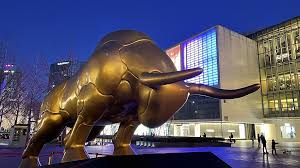Shares have soared in Shanghai but gave up a chunk of their initial gains as officials in Beijing outlined details of the government’s stimulus plans
Shares soared Tuesday in Shanghai as Chinese markets reopened after a weeklong holiday but then gave up a chunk of their initial gains as officials in Beijing outlined details of plans to revive the world’s second-largest economy.
The Shanghai Composite index was up 5.5% at 3,519.88 and in Shenzhen, Japan’s smaller market, the main index gained 5.3%. The Shanghai benchmark initially gained 10% but fell back as officials of China’s main economic planning agency briefed reporters about a slew of policies announced earlier meant to address key problems such as a property market slump.
Hong Kong’s Hang Seng sank 5.8% to 21,758.45 as traders sold to lock in profits from recent gains.
“China’s markets rally has hit a wall, leaving investors deflated. The reopening surge from the week-long holiday barely had time to gather steam before fizzling out, and now the once-thrilled bulls are licking their wounds,” Stephen Innes of SPI Asset Management said in a commentary.
Elsewhere in Asia, markets were mostly lower.
Tokyo’s Nikkei 225 index lost 1.2% to 38,861.09. as the dollar fell to 147.91 Japanese yen from 148.18 yen. A weaker yen tends to push share prices higher.
The Kospi in Seoul declined 0.5% to 2,596.38. Australia’s S&P/ASX 200 edged 0.2% to 8,187.10.
On Monday, U.S. stocks slid after Treasury yields hit their highest levels since the summer and oil prices continued to climb.
The S&P 500 dropped 1% to 5,695.94 and is still close to its all-time high set a week earlier. The Dow Jones Industrial Average fell 0.9% to 41,954.24, coming off its own record. The Nasdaq composite sank 1.2% to 17,923.90.
It’s a stall for U.S. stocks after they rallied to records on relief that interest rates are finally heading back down, now that the Federal Reserve has widened its focus to include keeping the economy humming instead of just fighting high inflation. A blowout report on U.S. jobs growth released Friday raised optimism about the economy and hopes that the Fed can pull off a perfect landing for it.
When Treasury bonds, which are seen as the safest possible investments, are paying more in interest, investors become less inclined to pay very high prices for stocks and other things that carry the bigger risk of losing money.
It’s more difficult to look attractive to investors seeking income when a 10-year Treasury is paying a 4.02% yield, up from 3.97% late Friday and from 3.62% three weeks ago.
The yield on the two-year Treasury, which more closely tracks expectations for the Fed, jumped more on Monday. It rose to 3.99% from 3.92% late Friday.
Treasury yields may also be feeling an upward push from the recent jump in oil prices. Crude prices have been spurting higher on worries that worsening tensions in the Middle East could ultimately lead to disruptions in the flow of oil.
Brent crude, the international standard, shed $1.23 to $79.70 per barrel. It had jumped 3.7% Monday. Benchmark U.S. crude, meanwhile, slipped $1.24 to $75.90. It also gained 3.7% on Monday.
Stocks that are seen as the most expensive can feel the most downward pressure from higher Treasury yields, and the spotlight has been on Big Tech stocks. They drove the majority of the S&P 500’s returns in recent years and soared to heights that critics called overdone.
Apple fell 2.3%, Amazon dropped 3% and Alphabet sank 2.4% to act as some of Monday’s heaviest weights on the S&P 500.
An exception was Nvidia, which rose another 2.3%. It rode another upswell in excitement about artificial intelligence technology after Super Micro Computer soared 15.8% after saying it recently shipped more than 100,000 graphics processing units with liquid cooling.
If Treasury yields keep rising, companies will likely need to deliver bigger profits to drive their stock prices much higher, and this week marks the start of the latest corporate earnings reporting season.
Analysts say earnings per share grew 4.2% during the summer for S&P 500 companies from a year earlier, led by technology and healthcare companies, according to FactSet. If those analysts are correct, it would be a fifth straight quarter of growth.
In other dealings early Tuesday, the euro rose to $1.0986 from $1.0977.
Source: abcNEWS



Recent Comments